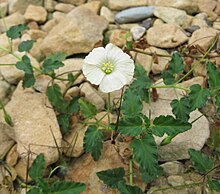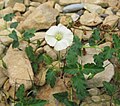| Monsonia | |
|---|---|

| |
| Monsonia emarginata | |
| Scientific classification | |
| Kingdom: | Plantae |
| Clade: | Tracheophytes |
| Clade: | Angiosperms |
| Clade: | Eudicots |
| Clade: | Rosids |
| Order: | Geraniales |
| Family: | Geraniaceae |
| Genus: | Monsonia L. |
Monsonia is a genus of plants in the family Geraniaceae. It is named after Lady Anne Monson, 1714–76, known for her botanical knowledge and plant collecting in the Cape.
Description
Monsonia consists of herbs or undershrubs often with simple stem from woody rootstock or deep tap root; leaves toothed or divided; flowers regular, petals 5, separate, tip broad, blunt or slightly notched, stamens in 5 groups with 3 stamens in each, one longer than others, ovary 5 lobed; fruit beaked.
Taxonomy
As of July 2020, the World Checklist of Selected Plant Families accepts 27 species:
|
|
Distribution
Distributed in Africa, Western Asia and East India, approximately 40 species, approximately 21 in South Africa.
Gallery
-
 Monsonia emarginata
Monsonia emarginata
-
 Monsonia attenuata
Monsonia attenuata
-
Monsonia umbellata
-
 Monsonia praemorsa seeds.
Monsonia praemorsa seeds.
-
 Monsonia angustifolia seeds.
Monsonia angustifolia seeds.
References
- "Plants of the world online". Royal Botanic gardens, Kew.
- A Field Guide to Wild Flowers Kwazulu-Natal and the Eastern Region by Elsa Pooley, Natal Flora Publications Trust, first edition 1998, ISBN 0-620-21500-3
- wild Flowers of Niorthern South Africa by Gerrit Germishuizen, Fernwood Press 1997, ISBN 1-874950-29-6
| Taxon identifiers | |
|---|---|
| Monsonia |
|
This Geraniaceae-related article is a stub. You can help Misplaced Pages by expanding it. |